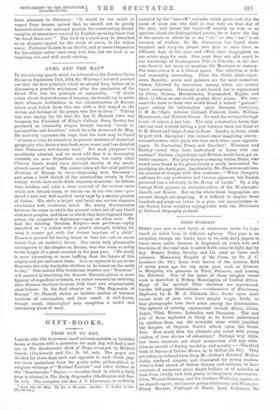EVERY year sees a new batch of wholesome books for
boys based on noble lives in different spheres. This year is ne exception, though the books have to vie with daily papers in times when active heroism is displayed on every side and fractions of the total that is called forth come to light day by day. Messrs. Seeley, Service, and Co. send us three such volumes. Missionary Knights of the Cross, by Dr. J. C. Lambart (2s. 6d.), deals with heroes of the mission field of many years ago for the most part, such as Gilmour in Mongolia, the pioneers in Tibet, Formosa, and 'a mong the Eskimos. One of the latest of these knights whose work is described is Bishop Hannington, of Central Africa. Many of his spirited little sketches are reproduced, besides full-page illustrations.- Adventaree of Misaionary Explorers, by Be M. A. Ibbotson (5s.), draws upon more recent work of men who have sought virgin fields, no that photographs take their place among the illustrations. The spheres of activity represented include Africa, China, Japan, Tibet, Borneo, Labrador, and Paraguay. The real aim of these explorers is likely to be better understood by children than, say, the scientific aims which justified the dangers of Captain Scott's attack upon the South Pole. How much does the ultimate aim count with young readers of true stories of adventure P Perhaps very little, but these accounts can stand comparison with any other tales as records of daring, hardship, and novelty.—The third book is Stories of Indian Heroes, by E. Gilliat (as. 6d.). They are taken in reduced form from. Mr. Gilliat's Heroes of Modern India, rendered simpler, and illustrated for young readers. After a brief sketch of Indian history and customs, we have accounts of numerous great Anglo-Indians or of episodes in their lives, vividly told with plenty of imaginary conversation. Clive, Warren Hastings, and the brothers Wellesley appear, es_ we should expect; the famous young missionary and Wrangiw, Henry Murtyn; Pottinger of Herat, Lord Dalhousie, $ir Herbert Edwardes, and others, The last is a simple and vivid account, but Ruskin's. Crown of Wild Olives remains for boys the best picture of Edwardes. The book should serve well as an invitation to Indian history and, like the others,. as a stimulus to noble living for great MUMS:















































 Previous page
Previous page